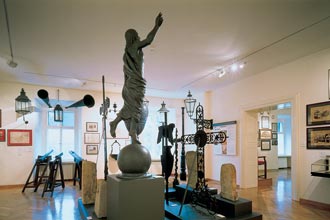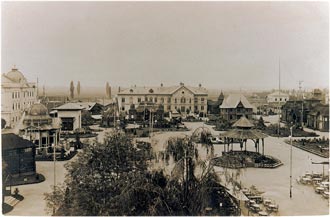Permanent Display 36. Public Utilities
 The rapid growth of Zagreb in the second half of the nineteenth century necessitated that urgent steps be taken to improve and update the city’s public utilities.
The rapid growth of Zagreb in the second half of the nineteenth century necessitated that urgent steps be taken to improve and update the city’s public utilities.
The city authorities first took care of the public lighting, and the old and not very numerous paraffin lamps were replaced, in 1863, by new and much more plentiful gas lamps in the centre of the Lower Town, and these were in turn replaced by electrical lighting in 1907.
One of the most important problems of the utilities was the drinking water supply.
This problem had concerned Zagreb people as early on as 1773, when Ivan Vetter, an engineer from Križevci, had drawn up a plan for a Zagreb water supply system, which was to have drawn its water from the spring Kraljičin zdenac. However, this plan never became reality, because of the expense of the project. With great pomp and circumstance, the City Water Supply System was opened in Jelačić Square as late as 1878.
The same year, the system of numbering houses according to streets, and not according to census lists, was brought in.
In the seventies, the old municipal cemeteries which had been caught within the walls were gradually abandoned. The modern city needed a new central cemetery, one to unite all confessions, and so the cemetery called Mirogoj was set up on the slopes to the north of the city in 1876. This was to become an important component of the city, by reason of the way it was conceived and its architecture.
The streets in the centre of the city were systematically paved and asphalted at the end of the century. In 1893 there was even a Regulatory Statute for the putting down of pavements. Culverts were provided for the many streams that flowed through the city centre, including the stream called Medveščak, that centuries-old border between the two territories of Gradec and Kaptol.
At the end of the century, Zagreb was provided with public transport; as well as cabs and omnibuses, in 1891 a horse-drawn tram linked the city and its outskirts. It was only in 1910 that the tram was electrified.
In 1899 a funicular railway was opened that linked the Upper and Lower Towns.
At the end of the 19th century, Zagreb experienced rapid expansion, turning into a modern Central European city, in which the population increased by 48.9% in the last decade of the century, counting 57,000 by the year 1900.
Nada Premerl
Economic exhibitions
The first International Exhibition in London of 1851 was visited by a group of Zagreb merchants so that they could develop craft products in London, as Naum Mallin said when he was seeking a passport to make this great journey. In Zagreb, one memorial of the visit was the candelabra bought then and set up in Jelačić Square. In the 1862 London Exhibition, exhibitors from Croatia actually took part.
With the encouragement of this success, it was proposed that the First Economic Exhibition be held in Zagreb; this was officially opened on August 18, 1864, in the unused building of the National Hospital and the square in front of it. It was enormously successful, with 3,886 exhibitors taking part.
 On the occasion of the 50th anniversary of the Croatian and Slavonian Economic Society, a second great business event was prepared, the Jubilee Exhibition of 1891. This attracted over 450,000 visitors, which was ten times more than the population of Zagreb at the time. The exhibition was accompanied by other events important for the city: the Botanical Garden was opened, the horse tramway was launched, and a monument to Fra Andrija Kačić Miošić was unveiled.
On the occasion of the 50th anniversary of the Croatian and Slavonian Economic Society, a second great business event was prepared, the Jubilee Exhibition of 1891. This attracted over 450,000 visitors, which was ten times more than the population of Zagreb at the time. The exhibition was accompanied by other events important for the city: the Botanical Garden was opened, the horse tramway was launched, and a monument to Fra Andrija Kačić Miošić was unveiled.
Business figures from Zagreb took part in many European exhibitions, and the prizes they won at the fairs were proudly shown in the adverts of their products and store windows.
Željka Kolveshi

